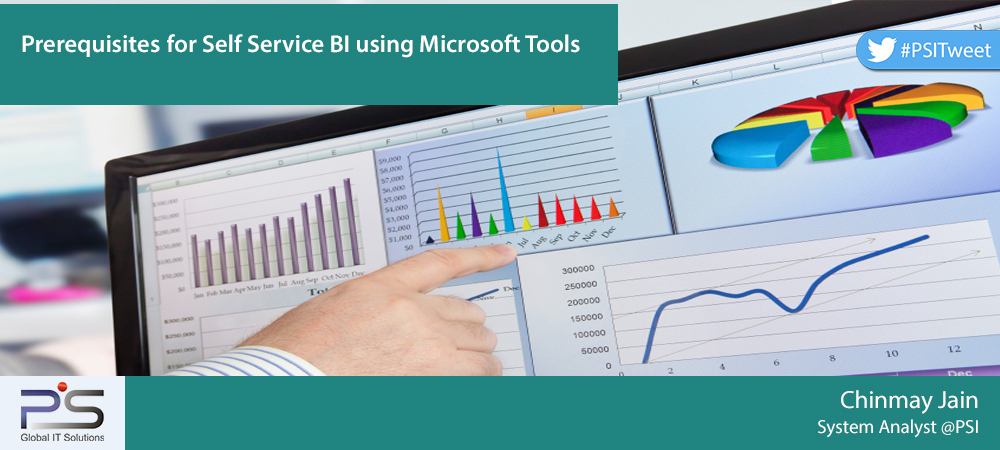Self-service business intelligence is a data analytics approach to enables business users to access and analyse the corporate information without IT department’s involvement. The focus is on business utility of the BI technology capabilities. This encourages the users to generate reports and take decisions based on data rather intuition.
To plan and implement self-service BI solution we need work on some prerequisite information.
In an organization, users require different business information and this knowledge helps us develop user friendly solutions
- Few users may require not only pre generated reports but a combination of different reports to as per the requirements.
- Empowered users who dissect the data, identify trends, and merge data for the required output.
- Users using just spreadsheets as reporting tools.
- Users with little IT experience.
- Users/top management utilising KPI to capture the performance in seconds.
Create a list of reporting requirements
- Key reporting areas like Sales, Purchase Orders, Production Cost, Product Categories and Customers etc.
- List of Reports ‘Reports which are frequently in use and multiple users require them’ for every area with functionality. In the initial phase users are trained to generate and design the reports on their own in self-service BI System.
- KPI which are relevant in business model.
Understand the Microsoft BI Tool which can help us to design solution
- SSRS: Environment wherein users can design and deploy pre-defined reports.
- SSIS: ETL Tools by which users can extract the data from multiple location, store at one location and can transform data, if required. These tools can also be used to create workflow for repetitive tasks.
- SSAS: Used to create cubes using data from data marts / data warehouse for deeper and faster data analysis. With large historical data, it aggregates the data on all available combinations and creates a cube which helps user for prompt and deep analysis.
- Excel: Microsoft’s best reporting tool to create ad-hoc reports. User can copy the data directly into excel and create a table, pivot, perform conditional formatting, write expressions and pivot graphs also. Excel can be directly used for Power Query, Power Pivot, Power View, and Power Map work seamlessly together to extend BI functionality and help you turn data into meaningful information.
- SSRB: SQL Server Report Builder tool on which end users can design and deploy reports, they may require usage training.
The ability to access and control information raises satisfaction levels in the users and improves the performance levels. The users can resolve the concern issues on their own. Thus, Self Service BI empower users with data analytics.
Image Courtesy: https://www.envisionit.comSelf-service business intelligence is a data analytics approach to enables business users to access and analyse the corporate information without IT department’s involvement. The focus is on business utility of the BI technology capabilities. This encourages the users to generate reports and take decisions based on data rather intuition.
To plan and implement self-service BI solution we need work on some prerequisite information.
In an organization, users require different business information and this knowledge helps us develop user friendly solutions
- Few users may require not only pre generated reports but a combination of different reports to as per the requirements.
- Empowered users who dissect the data, identify trends, and merge data for the required output.
- Users using just spreadsheets as reporting tools.
- Users with little IT experience.
- Users/top management utilising KPI to capture the performance in seconds.
Create a list of reporting requirements
- Key reporting areas like Sales, Purchase Orders, Production Cost, Product Categories and Customers etc.
- List of Reports ‘Reports which are frequently in use and multiple users require them’ for every area with functionality. In the initial phase users are trained to generate and design the reports on their own in self-service BI System.
- KPI which are relevant in business model.
Understand the Microsoft BI Tool which can help us to design solution
- SSRS: Environment wherein users can design and deploy pre-defined reports.
- SSIS: ETL Tools by which users can extract the data from multiple location, store at one location and can transform data, if required. These tools can also be used to create workflow for repetitive tasks.
- SSAS: Used to create cubes using data from data marts / data warehouse for deeper and faster data analysis. With large historical data, it aggregates the data on all available combinations and creates a cube which helps user for prompt and deep analysis.
- Excel: Microsoft’s best reporting tool to create ad-hoc reports. User can copy the data directly into excel and create a table, pivot, perform conditional formatting, write expressions and pivot graphs also. Excel can be directly used for Power Query, Power Pivot, Power View, and Power Map work seamlessly together to extend BI functionality and help you turn data into meaningful information.
- SSRB: SQL Server Report Builder tool on which end users can design and deploy reports, they may require usage training.
The ability to access and control information raises satisfaction levels in the users and improves the performance levels. The users can resolve the concern issues on their own. Thus, Self Service BI empowers users with data analytics.
Image Courtesy: https://www.envisionit.com[:]









